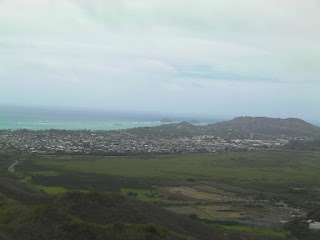This was the fourth time hiking the Kuli'ou'ou ridge hike. The hike actually has two options. Going into the valley or going up to the top of the Ko'olau mountain range. Most hikers opt for the ridge, as it offers some of the most spectacular views of O'ahu. On a clear day you can see all the way to diamond head towards town and Mokapu on the Windward side. The hike gets the most difficult toward the end making it one of the most climactic hikes on the island, with a beautiful view waiting for you right at the end.
The beginning of the hike starts at the end of a culdesac. A stone sign of the Board of Water Supply will say Kuli'ou'ou 350 Reservoir. If you see the sign you are in the right place. Don't go off to the right, but rather walk down the hill. Going off to the right will lead you to a water tower.
You will quickly enter into a world of trees and rocks. This part of the hike is very easy, and is really quite a nice stroll in the park. It is a lot easier than the later parts of the hike.
As you get further in you will come across an intersection in the trail. If you want to go into the valley keep going straight. If you want to get to the top of the ridge turn to the right up an incline. Up that incline you will see a sign telling you to use the trail because not using it will cause erosion. The trail will quickly become a winding path after this. Higher up is where you will start to see pine trees like the ones on the left. These are usually one of my most favorite parts of any hike. Pine trees seem to keep the place so peaceful.
Even higher up, you will start to see the Norfolk pines. These are really a sight to see as many of them are still quite young. You can tell the bigger ones have been growing for a very long time though already. In the particular area in the picture on the right, there were many younger pines. It is a nice refreshing experience to walk through a bunch of adolescant pine trees.
At one point you will come to a clearing with a shack located at the foot of the next incline. Be sure to take a rest here unless you are really determined to get to the top in a certain amount of time. After this point, the hike becomes fairly steep and difficult.
Notice that after the shack, the trees become significantly larger. They are also predominantly pines. Watch out for the pine roots sticking out of the ground as they might trip you and become very slippery when wet. On our way down the hike it rained and the roots became very slippery and dangerous. Use the pine roots to your advantage by using them as steps when you come to the steep parts.
The hike will get very steep and there will begin to be man-made steps. The trail itself is suffering from erosion so I think the steps actually mitigate the rate of erosion. The hike is climactic because not too far from the photo above, you will instantly come across the photo on the left, letting you see an excellent view of the Windward side. Too bad the day we went was kinda cloudy. The view wasn't as good, but I have to admit the coolness factor was still there.
Toward the left at the top facing the Windward side, you will see the Mokulua isalnds Before the islands on land is Bellows Air Force Station and a bunch of farms in Waimanalo.
Rabbit island or Manana can be seen toward the right facing the Windward side. You can see in the picture of Manana on the left that there were many clouds. I was lucky enough to get this picture off as after I took the picture a bunch of clouds rolled in.
The top of the ridge is actually very cold as the wind was super strong that day. Also, if the wind is strong, you will have to close your eyes from time to time to prevent dirt from flying in. The picture on the right was taken when we just started our descent. Notice Koko Head Crater on the left and the rest of Hawaii Kai on the right hand side.
The Kuli'ou'ou Experience
This hike will always be one of my favorites on the island. You go through so many different types of terrain and I love how the hike is climactic, ending in spectacular fashion. It seems like you can go further down the Ko'olau mountain range, but I haven't ever done so and wouldn't really recommend it unless you were a pretty good hiker. We made the mistake of going straight into the valley at first because we missed the section that led you up to the ridge. We quickly realized this however, and backtracked. In all, a very nice hike that is hiked best on a clear day.
Hawaiian Language Glossary
Kuli'ou'ou: Sounding knee (name refers to a small drum that was tied to the knee and played while performing the hula). "Hawaii Place Names"
Ko'olau: Short for ko'oko'olau - Windward sides of the Hawaiian Islands.
Waimanalo: Potable water














































